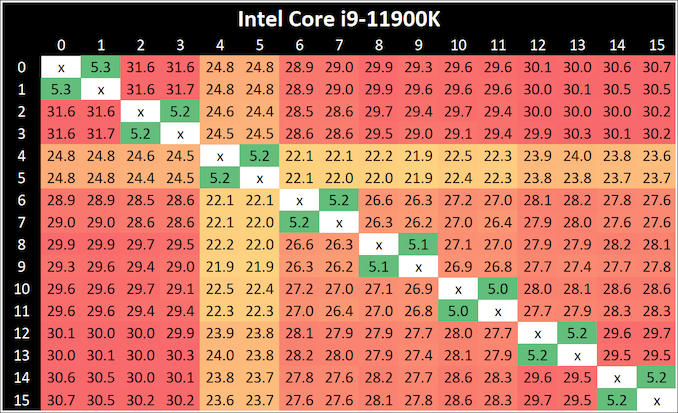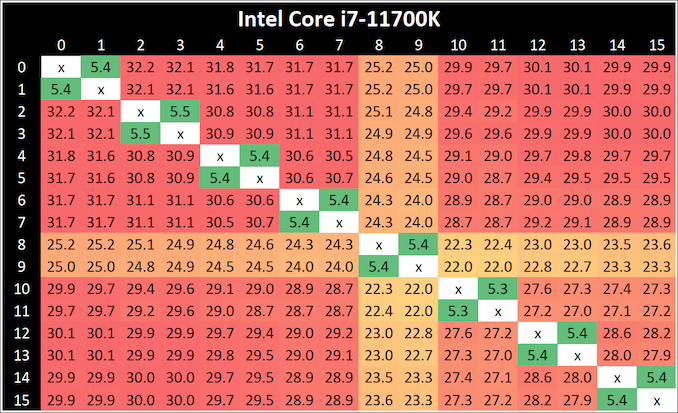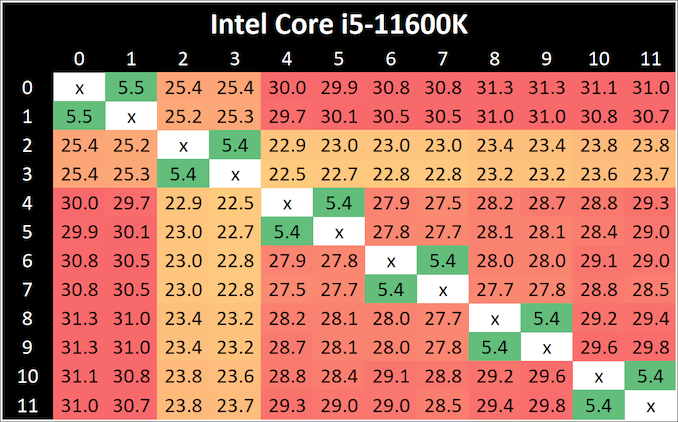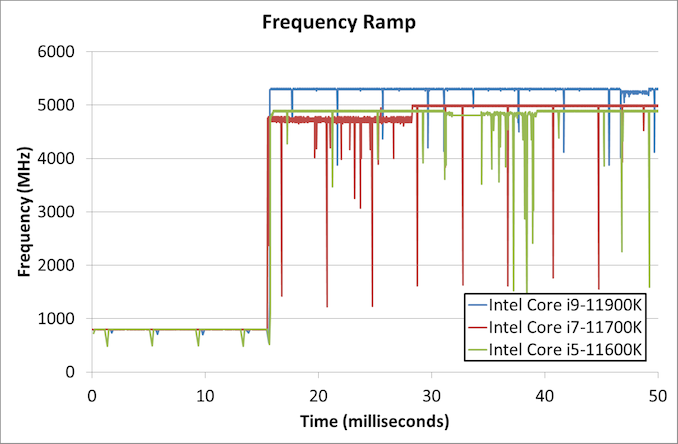Intel Rocket Lake (14nm) Review: Core i9-11900K, Core i7-11700K, and Core i5-11600K
by Dr. Ian Cutress on March 30, 2021 10:03 AM EST- Posted in
- CPUs
- Intel
- LGA1200
- 11th Gen
- Rocket Lake
- Z590
- B560
- Core i9-11900K
CPU Tests: Microbenchmarks
Core-to-Core Latency
As the core count of modern CPUs is growing, we are reaching a time when the time to access each core from a different core is no longer a constant. Even before the advent of heterogeneous SoC designs, processors built on large rings or meshes can have different latencies to access the nearest core compared to the furthest core. This rings true especially in multi-socket server environments.
But modern CPUs, even desktop and consumer CPUs, can have variable access latency to get to another core. For example, in the first generation Threadripper CPUs, we had four chips on the package, each with 8 threads, and each with a different core-to-core latency depending on if it was on-die or off-die. This gets more complex with products like Lakefield, which has two different communication buses depending on which core is talking to which.
If you are a regular reader of AnandTech’s CPU reviews, you will recognize our Core-to-Core latency test. It’s a great way to show exactly how groups of cores are laid out on the silicon. This is a custom in-house test built by Andrei, and we know there are competing tests out there, but we feel ours is the most accurate to how quick an access between two cores can happen.
All three CPUs exhibit the same behaviour - one core seems to be given high priority, while the rest are not.
Frequency Ramping
Both AMD and Intel over the past few years have introduced features to their processors that speed up the time from when a CPU moves from idle into a high powered state. The effect of this means that users can get peak performance quicker, but the biggest knock-on effect for this is with battery life in mobile devices, especially if a system can turbo up quick and turbo down quick, ensuring that it stays in the lowest and most efficient power state for as long as possible.
Intel’s technology is called SpeedShift, although SpeedShift was not enabled until Skylake.
One of the issues though with this technology is that sometimes the adjustments in frequency can be so fast, software cannot detect them. If the frequency is changing on the order of microseconds, but your software is only probing frequency in milliseconds (or seconds), then quick changes will be missed. Not only that, as an observer probing the frequency, you could be affecting the actual turbo performance. When the CPU is changing frequency, it essentially has to pause all compute while it aligns the frequency rate of the whole core.
We wrote an extensive review analysis piece on this, called ‘Reaching for Turbo: Aligning Perception with AMD’s Frequency Metrics’, due to an issue where users were not observing the peak turbo speeds for AMD’s processors.
We got around the issue by making the frequency probing the workload causing the turbo. The software is able to detect frequency adjustments on a microsecond scale, so we can see how well a system can get to those boost frequencies. Our Frequency Ramp tool has already been in use in a number of reviews.
From an idle frequency of 800 MHz, It takes ~16 ms for Intel to boost to the top frequency for both the i9 and the i5. The i7 was most of the way there, but took an addition 10 ms or so.














279 Comments
View All Comments
Qasar - Thursday, April 1, 2021 - link
" calling out Intel shills when I see them " ahh so you are calling out your self then ?the point you are making, is more like your own OPINION then any thing else. while YOU may not see the point in getting a cheap vid card so you can at least use the over all better cpu ( zen 3) then this dud, others may be fine with it. a few people i work with, are currently waiting for zen 3 to be in stock, and will upgrade to it, they have seen the reviews of rocket lake, and have no issues waiting, cause they know they will still be getting the better cpu.
" then there is zero value in any AMD CPU currently. " again YOUR opinion.
vanish1 - Friday, April 2, 2021 - link
Youre cherry picking words from my overall statement, nice try Intel shill. IF YOU ARE BUILDING A NEW PC RIGHT NOW THERE IS ZERO VALUE IN AMD CPUS. Some people actually care about spending their money frugally, not having to spend hundreds of dollars on a GPU they dont want just to make their CPU work.Beyond that, if E-peen matters so much to you and money is no object then why waste your cash in the first place on E-waste GPU, isnt it even more baller to buy a GPU when its most expensive? If you care so much about having the BEST cpu that does the BEST in every benchmark, how dare you grace its presence with such a lowly dGPU like a rx550 or gtx970? Hmmm conflict of interest, picks and chooses what part of the GPU crisis to support instead of skipping it completely.
Sorry you two, some of us live in the real world where money matters more than E-peen and video gaming addictions.
Qasar - Friday, April 2, 2021 - link
and you are trying to make an argument that so far, only YOU seem to be making, on here, and on other sites. YOU are the intel shill here, not me, nice try, if i was an intel shill would i be calling rocket lake a dud, or the better cpu being Zen 3 ? " IF YOU ARE BUILDING A NEW PC RIGHT NOW THERE IS ZERO VALUE IN AMD CPUS " and its YOUR opinion, plain and simple, while YOU see no value in them, i'd guess others see A LOT more value in them, then rocket lake." not having to spend hundreds of dollars on a GPU they dont want just to make their CPU work. " ahh so now, 50 bucks is hundreds if dollars ? and its doubtful someone buying the top, lets say 2 rocket lake cpus, is going to then use the IGP to play games on, that are recent, come on, get real.
with the way you keep crying about a 50 buck gpu being ewaste, you must have a comp that is quite old, so you can flex you own epeen, and not contribute e waste your self.
the fact that you are now, resorting to insults and name calling, proves nothing more then the fact you are probable just a child, have a good day, and i hope your old comp doesnt die on you, so you have to contribute to e waste yourself.
BushLin - Friday, April 2, 2021 - link
vanish1: OMG ewaste! OMG be frugal with money...Also vanish1: advocates buying 200w CPU on 6 year old 14nm process and a new motherboard which won't support future 10nm/7nm CPUs. Delivering about half the performance per watt of current AMD CPUs and needs custom water cooling or datacentre loud fans just to do that.
You're either an Intel shareholder, somehow trying to justify to yourself your bad purchase or just... you know, dumb.
vanish1 - Friday, April 2, 2021 - link
@qasar go home bud, you lost the argument days ago.@bushlin ahhh you, the shill, continues to spread FUD. You know nanometer size isnt a 1:1 standard across the industry right? https://www.youtube.com/watch?v=ROS008Av4E4 Linus is asking you sit down now please.
Beyond that, most people actually use their computer for longer than a product cycle and could really care less what cpu upgrade path exists, if you genuinely think 5 years from now a 6 or 8 core processor will be out of date then you need to seriously need to get your head checked. PC industry standards move independently of each category. You think SK Hynix cares about Intel and AMDs CPU upgrade paths when theyre ready to push DDR5 onto the world? (the answer is no).
11600k + mobo + money in my pocket = winning
5600x + mobo - overpriced dGPU to make it work = losing
BushLin - Friday, April 2, 2021 - link
" You know nanometer size isnt a 1:1 standard across the industry right?"Yes, obviously since I talked about *future* 10nm/7nm CPUs which only applies to Intel's metric as TSMC are knocking out 7nm Zen3 and 5nm Apple SoCs.
"11600k + mobo + money in my pocket = winning"
You have an office PC for a couple of years, by the time GPU shortages end you've got a terrible value for money, inefficient platform to slot a GPU into; by then, the same money you spent today would buy you a 5nm/3nm CPU with better IPC, DDR5 and even bigger gulf in performance per watt compared to your space heater, factory overclocked build.
Qasar - Friday, April 2, 2021 - link
sounds more like you lost the argument as i have suggested counter point to you BS claims about ewaste and such. bottom line is, from what it sounds like you only prefer the intel cpus, cause of the iGPU, which is fine but there ARE other options, its just you sound to cheap to consider them. a discrete vid card, can and could be used in pretty much any comp, so its not a waste as you claim.11600k + mobo + money in my pocket = winning
5600x + mobo - overpriced dGPU to make it work = losing
this is YOUR opinion nothing more.
29a - Friday, April 2, 2021 - link
I just bought a brand new AMD processor.vanish1 - Monday, April 5, 2021 - link
https://youtu.be/KPgmeNstLa8?t=722Where the clip starts the first guy has a Ryzen system sitting unused, using his phone instead.
The next one after, same situation no GPU, but Intel build, and look its running.
step back fade away J for the win at the buzzer.....swooshhhhhh
vanish1 - Monday, April 5, 2021 - link
Seriously; outside of work, do not support the GPU industry currently in any form, shape, or manner.